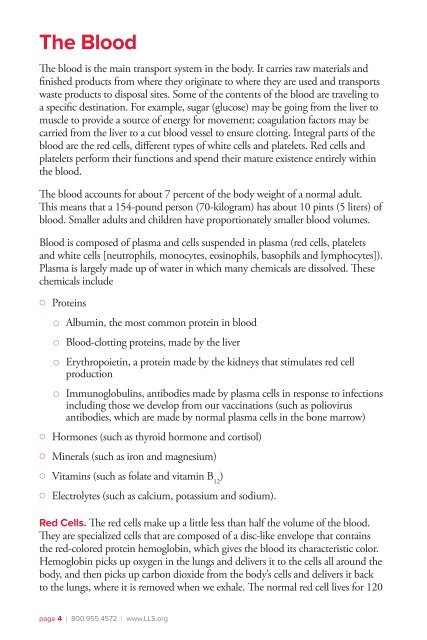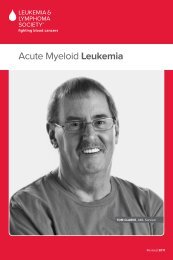Blood Transfusion (PDF) - The Leukemia & Lymphoma Society
Blood Transfusion (PDF) - The Leukemia & Lymphoma Society
Blood Transfusion (PDF) - The Leukemia & Lymphoma Society
You also want an ePaper? Increase the reach of your titles
YUMPU automatically turns print PDFs into web optimized ePapers that Google loves.
<strong>The</strong> <strong>Blood</strong><br />
<strong>The</strong> blood is the main transport system in the body. It carries raw materials and<br />
finished products from where they originate to where they are used and transports<br />
waste products to disposal sites. Some of the contents of the blood are traveling to<br />
a specific destination. For example, sugar (glucose) may be going from the liver to<br />
muscle to provide a source of energy for movement; coagulation factors may be<br />
carried from the liver to a cut blood vessel to ensure clotting. Integral parts of the<br />
blood are the red cells, different types of white cells and platelets. Red cells and<br />
platelets perform their functions and spend their mature existence entirely within<br />
the blood.<br />
<strong>The</strong> blood accounts for about 7 percent of the body weight of a normal adult.<br />
This means that a 154-pound person (70-kilogram) has about 10 pints (5 liters) of<br />
blood. Smaller adults and children have proportionately smaller blood volumes.<br />
<strong>Blood</strong> is composed of plasma and cells suspended in plasma (red cells, platelets<br />
and white cells [neutrophils, monocytes, eosinophils, basophils and lymphocytes]).<br />
Plasma is largely made up of water in which many chemicals are dissolved. <strong>The</strong>se<br />
chemicals include<br />
{ { Proteins<br />
{ { Albumin, the most common protein in blood<br />
{ { <strong>Blood</strong>-clotting proteins, made by the liver<br />
{ { Erythropoietin, a protein made by the kidneys that stimulates red cell<br />
production<br />
{ { Immunoglobulins, antibodies made by plasma cells in response to infections<br />
including those we develop from our vaccinations (such as poliovirus<br />
antibodies, which are made by normal plasma cells in the bone marrow)<br />
{ { Hormones (such as thyroid hormone and cortisol)<br />
{ { Minerals (such as iron and magnesium)<br />
{ { Vitamins (such as folate and vitamin B ) 12<br />
{ { Electrolytes (such as calcium, potassium and sodium).<br />
Red Cells. <strong>The</strong> red cells make up a little less than half the volume of the blood.<br />
<strong>The</strong>y are specialized cells that are composed of a disc-like envelope that contains<br />
the red-colored protein hemoglobin, which gives the blood its characteristic color.<br />
Hemoglobin picks up oxygen in the lungs and delivers it to the cells all around the<br />
body, and then picks up carbon dioxide from the body’s cells and delivers it back<br />
to the lungs, where it is removed when we exhale. <strong>The</strong> normal red cell lives for 120<br />
page 4 I 800.955.4572 I www.LLS.org

















